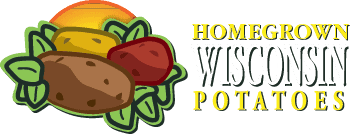By Gloria Freeland and her husband, Art Vaughan, visitors to the Wisconsin Spudmobile in Eagle River.
Traveling billboard fulfills mission of touting important role of potatoes in agriculture
My husband, Art, has often said, “I’ve never met a potato I didn’t like.” As a Wisconsin native, his enjoyment of this bulbous tuber may come naturally.
While Idaho is the state that produces the most potatoes, the Badger State comes in number three, with Washington between them.
So, when I heard that the Spudmobile would make a stop near our Wisconsin north woods cottage, I knew we should check it out.
The almost-40-foot-long RV with “Wisconsin Spudmobile” emblazoned across the top above photos of potatoes and potato fields was an imposing sight, although Art said he was disappointed the vehicle wasn’t shaped like the vegetable.
Trig’s grocery store in Eagle River played host and paired the visit with ads for “Potato Days,” featuring specials on items such as russets, big baking potatoes, Yukons, “Darn Good Potato Salad” and potato sausage.
300-MEMBER ORGANIZATION
Stepping aboard the Spudmobile, we were immediately welcomed by Dana Rady and Doug Foemmel of the Wisconsin Potato & Vegetable Growers Association (WPVGA), which I learned is an organization of 300 members and affiliates.
Dana is the WPVGA director of promotions and consumer education, while Foemmel’s business card simply described him as “Spudmobile Education and Outreach Administrator.”
A group of 10 Trig employees was right behind us, so while Rady gave them a tour, I began quizzing Foemmel.
I learned that, since its first road trip in August 2014, the Spudmobile has visited hundreds of locations, including schools, state fairs, festivals, parades, Green Bay Packers and Chicago Bears football games, and stores like Trig’s that sell Wisconsin potatoes.
The state has 63,000 acres of potatoes, with each acre averaging 42,000 pounds. Some 100 varieties of potatoes are grown in Wisconsin, and it is home to the U.S. Potato Genebank, in Sturgeon Bay, one of four gene banks for wild potato varieties.
While approximately a quarter of the harvest is consumed fresh, more than a third is destined to become frozen French fries and other processed foods. Six percent are used as seed for the next crop.
The displays had many entertaining aspects as well, such as recipes for Mediterranean Crispy Potato Breakfast Roulade, Muffin Tin Baked Tex-Mex Mashed Potatoes, and Poblano Pepper and Potato Soup with Crispy Bacon.
Among the fun facts, I noticed the following:
- A potato was the first vegetable grown in space.
- Potatoes can be used to get rid of rust.
- Rest two slices of raw potato on your eyelids to reduce puffiness.
- The average American eats 120 pounds of potatoes a year.
- One medium potato (5.3 ounces) with the skin contains 45 percent of the daily value for vitamin C, more potassium (620 milligrams) than bananas, spinach or broccoli, 10 percent of the daily recommended allowance of Vitamin B6, 110 calories and no fat, sodium or cholesterol, assuming, of course, that you add no butter, sour cream, shredded cheese, bacon bits or salt.
Doing a bit of digging later, I discovered the term spud came from a sharp, narrow-bladed shovel that, among other uses, was once used to dig up the vegetables.
The closest ancestors of cultivated potatoes evolved in the Andes, where people domesticated the plant at least 7,000 years ago.
My sister, Gaila, lives in Bolivia, an Andean nation, and she has mentioned the hundreds of potato sizes and colors—black, red, pink, yellow and others—she has seen in the markets there.
In the 16th century, the Spanish took the tuber to Europe, where it was mostly fed to livestock. Europeans began to eat potatoes in earnest in the 1800’s and they caught on in popularity.
The plant can grow in cold climates and poor soil, and in some places, yields several crops each season. Once harvested, the tubers can be stored for months.
Art said many Wisconsin villages in the area where he grew up had potato storage facilities in the early years of the 20th century.
LOADING THE BOXCARS
During the winter, boxcars would periodically be loaded to transport them to places like Milwaukee and Chicago. Young men, including his uncle, Harold, traveled with the cars to tend the heaters that kept the potatoes from freezing.
For a small-town boy, it was quite an adventure and one he was paid to take.
So, the state’s interest in the vegetable is not new. In fact, the Badger Common’Tater logo dates from 1948 and its purpose is to be a source of information, news, education and highlights of the potato and vegetable industry in Wisconsin.
Foemmel said the Spudmobile’s purpose is also education—to inform people about the importance of agriculture in general and potatoes particularly. He said he found it hard to believe a teacher at one of their school visits didn’t know potatoes are grown in the ground.
Since we grew up on a Kansas farm, my siblings and I are aware of what it takes to raise food. My brother, Dave, remembers when our family planted 50 pounds of potatoes each spring just for our use.
PRIZE-WINNING POTATOES
He tended the garden and entered some of the harvest in the Butler County 4-H Fair each year, winning lots of blue ribbons. He has planted several types of vegetables, including potatoes, every year for nearly 50 years.
“You can’t take the country out of a boy,” he told me. “ … lots of work, but for a city boy, a good way to get some exercise!”
Art and I didn’t get much physical exercise visiting the Spudmobile, but we did exercise our brains.
And we got to sit on beanbag chairs that looked like loaded baked potatoes, complete with butter-pat pillows. Foemmel and Rady snapped pictures for their Facebook page.
“You know what?” Foemmel proclaimed, “Now you are real couch potatoes!”

